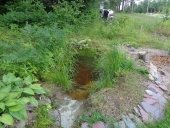Given the additional information you've provided, I suggest looking into clay pot irrigation. It'll dramatically reduce the amount of water you need to irrigate your new trees, while still ensuring hydration over extended periods. Reduced water consumption eases your workload and reduces the size of any pumping system you choose to implement. There are some profound effects as well; if your olla pots are of suitable size, weekend watering would result in week-long hydration... that means faster growth, less stress, and improved survival rates for your trees.
The most comprehensive single source of information on clay pot irrigation I know of is
http://permaculturenews.org/2010/09/16/ollas-unglazed-clay-pots-for-garden-irrigation/. There's a lot of information on it here on Permies.com as well.
I think you would be best off investing in a portable electric pump, a suitable sized solar panel, and a constant current controller. The combination need only supply a trickle of water all day. You'll be surprised how little flow it takes to add up to a few dozen gallons of water over hours. It's not a lot of work for a solar system... it's just a lot of work for human hands. The reason is obvious when you think about it. Your pump need only move the water, while you need to move yourself and the weight of the water. If we assume you need to move 20 gallons (8.4lbs per gallon), that you can move two gallons per trip, and that you weigh 150lbs... well then you have to move 165lbs up the hill ten times, while the pump need only move 168lbs up the hill one time.
You might be thinking the same logic applies to a manual pump. It doesn't. A manual pump is going to strain select muscle groups. Think sore back, sore arms, or sore legs. Whatever does the pumping is going to bear the strain. With that level of rise, no manual pump will beat the ease of a small solar config. Save your muscle power for the tasks that aren't easily automated.






